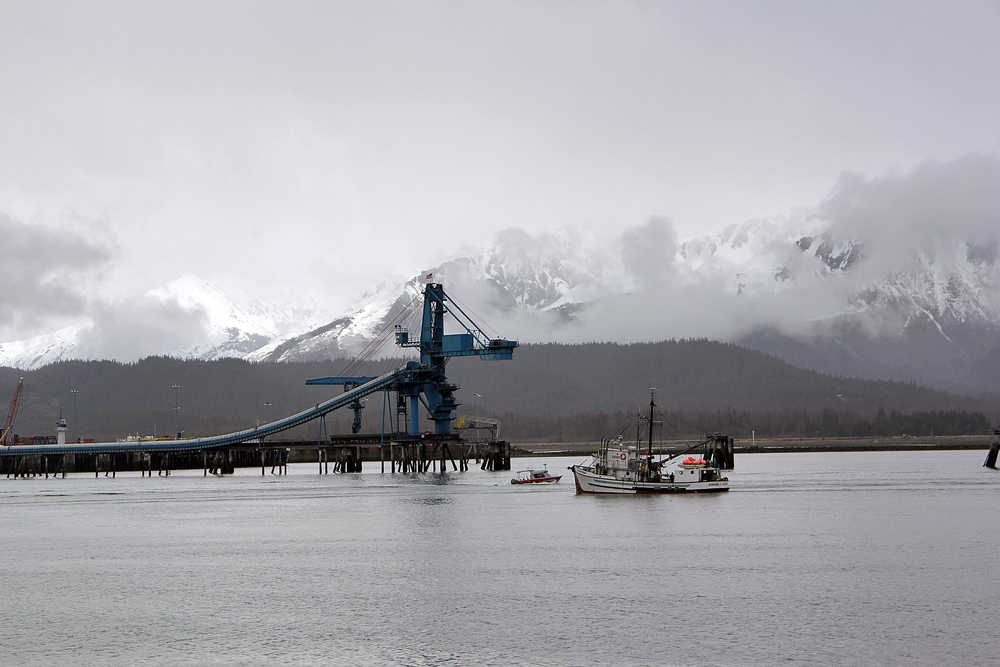The Seward Coal Loading Facility has applied for a permit that will cover coal falling into Resurrection Bay.
The permit, which is being reviewed by the Alaska Department of Environmental Conservation, would allow the facility to legally drop coal into a 21-acre area of Resurrection Bay. The plant, operated by Aurora Energy Services for the Alaska Railroad Corporation, sometimes drops coal into the bay during transfer from the storage facility onto a ship.
The company will be required to monitor the accumulation on the sea floor and report it if the accumulation “exceeds a moderate measurable increase,” according to the permit.
The company was the target of a 2009 lawsuit filed by the Anchorage-based Alaska Community Action on Toxics and the national Sierra Club. Initially, the district court ruled that the company’s stormwater runoff permit covered the “incidental coal” being dropped into the bay.
The Ninth Circuit Court later reversed that decision, ruling that the company would have to apply for a pollutant discharge permit to continue to spill coal into the bay. Though the case was sent to the Supreme Court for review, the court demurred, leaving the Seward Coal Loading Facility to go through the process of either putting in spill prevention measures or obtaining a pollutant discharge permit.
The Sierra Club announced Tuesday that it had reached a settlement with Aurora Energy Services and the Alaska Railroad Corporation. The facility will be required to make improvements and fund conservation projects in the Resurrection Bay watershed, which will be carried out by the Kachemak Heritage Land Trust.
Pamela Miller, the executive director of Alaska Community Action on Toxics, said the settlement was a step in the right direction. The company will provide $10,000 to Kachemak Heritage Land Trust for its projects, she said, which the plaintiffs had no say on.
The settlement is a positive step but not everything the facility needs to do, Miller said.
“I think it has taken this lawsuit to get things moving with (Aurora Energy Services),” Miller said. “It’s really too bad that it takes a lawsuit to have those kinds of improvements. I would hope that they would initiate these things on their own and be a good neighbor to the community in Seward.”
Aurora Energy Services is a subsidiary of Usibelli Coal Mine, which operates a mine in Healy. The facility is currently idle, but the company is working on export contracts for 2016, said Lorali Simon, the vice president of external affairs for Usibelli.
Simon said a diver will go down to examine the floor of Resurrection Bay for the monitoring surveys. She said divers have done examinations in the past and not found any coal accumulation.
“A diver goes down there and visually inspects,” Simon said. “From the last dive survey, that’s exactly what (the diver) did. He took some pictures, did a grid across the sea floor and did a report on if he found anything.”
Under the proposed permit, Aurora Energy Services is required to do the survey in the first year of the permit, then once every five years.
If the report shows any increase above the baseline, the company will move into an adaptive management plan. If any survey shows four or more inches of coal coverage over an acre, the company will be required to submit a remediation plan to the Department of Environmental Conservation, Simon said in an email.
Russ Maddox, a Sierra Club volunteer in Seward and a witness in the lawsuit, said although the company has taken positive steps to prevent some of the spillage, the plan to deposit coal on the bottom of the bay is flawed.
“They’re measuring it by what accumulates on the bottom, which is silly, because the tidal movement will certainly affect that,” Maddox said. “We have two major tidal movements that come in and out of here every day.”
The second draft of the permit did include some revisions that Maddox said would help, such as requiring the company to report the sea floor monitoring sooner after the permit goes into effect. Initially, the permit did not require the company to report the sea floor coal levels until four years after the permit was issued; the most recent draft requires reporting after one year.
The company has made some repairs on the facility to help prevent spillage, including the installation of a drip pan beneath the conveyor belt to collect any coal that may fall, Simon said.
Simon said in an email that the company has spent approximately $1 million on upgrading the environmental control systems at the facility and plans to continue improvements in 2016.
Miller said she was glad the company is making adjustments to be a better neighbor to Seward’s citizens. She said she hopes the public does not blame the Sierra Club and the AK Community Action on Toxics for any economic impact from the current closure of the facility.
“I think the shutdown of this facility was certainly not a direct result of our lawsuit by any means, but I think it is an indication of the crash of the global market,” Miller said. “I don’t think the shutdown of that facility was in direct response to our actions. We simply want this facility to be a good neighbor to the people of Seward.”
Public comment on the permit is open until Dec. 21 and can be submitted to the Department of Environmental Conservation office in Anchorage. Mailed comments and requests must be postmarked before the deadline.
Reach Elizabeth Earl at elizabeth.earl@peninsulaclarion.com.

